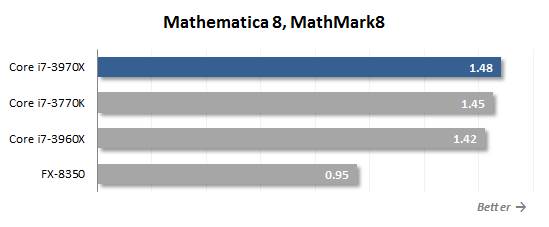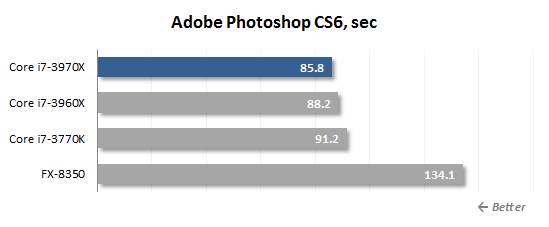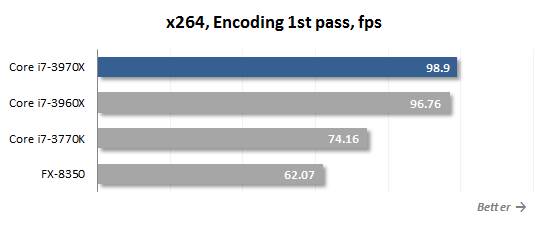App
performance
To test the microprocessors performance
during data storaging process we rearrange WinRAR archiving utility. Using maximum
compression, we storage a folder with multiple files with 1.1 GB total size.

Rearrange
WinRAR archiving utility
WinRAR version 4.2 has been clearly
optimized for multi-threading, that is the reason why six-core LGA 2011
micromicroprocessor perform very well here. Specifically, Core i7-3970X is more
efficient than Core i7-3770K by almost 25%.
Micormicroprocessor performance in encoding
tasks is measured by a built-in benchmark of the popular TrueCrypt utility,
using AES-Twofish-Serpent “triple” encryption. I have to say that this utility
not only loads any number of cores and work effectively, but also supports
special AES instructions.

Use
the AES-Twofish-Serpent “triple” ecription
Encoding tasks run well on eight-core AMD
micromicroprocessors, but the six-core Core i7-3970X easily shows that FX-8350
is its place. AMD microprocessors can face against Intel’s quad-core offers in
most cases, but in no case they can get close to the performance level of
six-core CPUs.
We use Apple iTunes utilities to test audio
transcoding speed. During the test, we transcode the contents of a CD disk into
AAC format. Note that the feature of this program is the exclusive
single-threaded load.

use
Apple iTunes utilities to test audio transcoding speed
This pretty interesting test reveals a few
weaknesses of Sandy Bridge-E design. Though the new Core i7-3970X is 2.5%
faster than the predecessor, it falls behind Core i7-3770K. This is exactly the
case when Ivy Bridge microarchitecture demonstrates relative performance, which
we mentioned above, better.
The popular scientific Mathematica software
set is ready, we decided to bring it back as one of our regular benchmarks. We
use MathematicaMark8 integrated into this software set to test the systems
performance:

Use
MathematicaMark8 to test the system performance
Still, higher frequency is not a problem to
the new Core i7-3970X in Mathematica 8, we it stays on top again.
We measured the performance in Adobe
Photoshop CS6, using our own benchmark which was made from Retouch Artists
Photoshop Speed Test that has been creatively adjusted. It includes specific
editing of 4 24-megapixel images from a digital camera.

Performance
in Adobe Photoshop CS6
Don’t think that micromicroprocessors like
Core i7-3970X need special multi-threaded environment. Even when the app doesn’t
use all the micromicroprocessor cores, the microprocessor still performs very
well. This is where Turbo Boost intervenes and increases its clock frequency to
4.0 GHz under loads with fewer threads. As a result, even when we run Photoshop
tests without applying any of the resource-hungry filters for the images, but
during typical diverse processing tasks, the leading LGA 2011 CPU will show
anontainably high performance number.
We have also shown some tests in Adobe
Photoshop Lightroom 4.2 program. The test situation includes post-processing
and exporting into JPEG format of 200 12-megapixel images in RAW format.

Adobe
Lightroom knows how to handle images using multithreads
Adobe Lightroom knows how to process images
using multiple threads, which is Core i7-3970X friendly environment. It proves
to be 2.5% faster than its predecessor and leaves Core i7-3770K 13% behind.
Performance in Adobe Premiere Pro CS6 is
determined by the time to build a Blu-ray project with a HDV 1080p25 video into
H.264 format and apply different special effects to it.

The
new Core i7-3970X is 32% faster in Premiere Pro CS5
HD video content processing is one of the
best kinds of load for multi-core micromicroprocessors. Therefore, systems with
top LGA 2011 CPUs will be a good choice for those who work a lot with HD
content. For example, the new Core i7-3970X is 32% faster in Pro CS5 system
than in the too LGA 1155 system.
In order to measure how fast CPUs
participating our tests can transcode a video into H.264 format, we use x264 HD
Benchmark 5.0. It works with an original video recorded in 1080p format with 20
Mbps bit rate. I have to say that the results of this test are one of great
practical value, because the x264 encoder is also part of numerous popular
transcoding utilities, such as HandBrake, MeGUI, VirtualDub, …

Use
x264 HD Benchmark 5.0

Core
i7-3970X is 30% faster
The results earned through video
transcoding tests are very similar to what we have already seen in Premiere
Pro. Core i7-3970X is 30% faster than the flagship microprocessors in any
alternative platforms.
We will test calculating performance and
rendering speeds in Autodesk 3ds max 2011 using the special SPECapc for 3ds max
2011 benchmark.

Calculating
performance in Autodesk 3ds max 2011

Rendering
speed in Autodesk 3ds max 2011
Rendering is another example of
multi-threading task, where the 1,000USD micromicroprocessors prove their
worthiness. Pro users will be very satisfied with all of them: Core i7-3970X,
as well as its predecessor, will be an excellent choice for a pretty-fast
work-station. The only replacement available in this situation, will be a
system based on dual microprocessor, such as Xeon E5.
Power consumption
We could easily predict that the new Core
i7-3970X will have higher performance than its predecessor by just looking at
its clock frequency. However, its higher thermal parameters make this testing
more inquisitive. Intel pushed TDP back to 20 W, but we doubt whether this is
true. In fact, the clock frequency didn’t increase much enough to cause a 15%
sudden heat dissipation increase. Besides, the voltage intervals on the new LGA
2011 microprocessors don’t change much. In other words, we expect some
increases in power consumption, but doubt that the new Core i7-3970X will
consume more 20 W under load than Core i7-3960X.
To find out more about the power
consumption of all microprocessor models in the new AMD FX line, we perform a circle
of special tests. The new digital power supply unit from Corsair - AX1200i -
allows monitoring consumed and produced, which we use effectively during power
consumption tests. The graphs below (unless there’re other rules) show the full
power line of the computer (without the monitor) measured after the power
supply. It is the total power consumption of all the system devices. The PSU's
efficiency is not taken into account. CPUs are loaded by running the 64-bit
version of LinX 0.6.4-AVX utility. Moreover, we allow Turbo mode and all
power-saving technologies to measure computer's power amount in idle mode
correctly: C1E, C6, Enhanced Intel SpeedStep and AMD Cool’n’Quiet.

Required
power with Core i7-3970X and Core i7-3960X in idle mode
In idle mode all microprocessors and platforms
usually consume the same power level. However, in case of LGA 2011 platform,
this rule doesn’t quite right. It looks like the more complex system structure
including a quad-channel memory controller and a PCI Express bus controller
supporting up to 40 lanes, may have affected the power consumption levels. As a
result, the required power of systems with Core i7-3970X and Core i7-3960X in
idle mode are about 20 W higher than simple LGA 1155 and Socket AM3+
configurations.

Power
consumption for single-threaded load
Single-threaded load also shows higher
power consumption levels for LGA 2011 systems. All six-core CPUs from Intel
consume more than an eight-core AMD microprocessor, which is normally the more
power-consumed contemporary microprocessor. However, Intel’s Sandy Bridge-E
design is not cut for energy savings. Moreover, when the new microprocessor
increases its frequency to 4.0 GHz in case of single-threaded load, it even
creates the new power consumption “record” leaving its predecessor far behind.

Power
consumption of maximum load
Of course, if you feel like yo can shock
anyone with your power consumption numbers, maximum load is the way. This is
where Core i7-3970X is the only leader. Its power consumption is so high, not
only puts the system with AMD FX-8350 to shame, but also more than doubles the
power for readings of the LGA 1155 configuration with a Core i7-3770K. However,
the difference in power consumption between the system with the new Core
i7-3970X and the system with Core i7-3960X doesn’t reach 20 W – only 12 W. In
other words, the newly declared TDP have some backups for another frequency
boost, allowing even faster six-core Sandy Bridge-E microprocessor to pop out
one day.